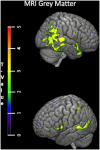Plasma Levels of Tissue-Type Plasminogen Activator (tPA) in Normal Aging and Alzheimer's Disease: Links With Cognition, Brain Structure, Brain Function and Amyloid Burden
- PMID: 35747448
- PMCID: PMC9211060
- DOI: 10.3389/fnagi.2022.871214
Plasma Levels of Tissue-Type Plasminogen Activator (tPA) in Normal Aging and Alzheimer's Disease: Links With Cognition, Brain Structure, Brain Function and Amyloid Burden
Abstract
Tissue-type plasminogen activator (tPA) is a protease known for its fibrinolytic action but is also involved in physiological and pathophysiological aging processes; including amyloid elimination and synaptic plasticity. The aim of the study was to investigate the role of tPA in cognitive and brain aging. Therefore, we assessed the links between tPA plasma concentration and cognition, structural MRI, FDG-PET and Flobetapir-PET neuroimaging in 155 cognitively unimpaired adults (CUA, aged 20-85 years old) and 32 patients with Alzheimer's disease (ALZ). A positive correlation was found between tPA and age in CUA (p < 0.001), with males showing higher tPA than females (p = 0.05). No significant difference was found between ALZ patients and cognitively unimpaired elders (CUE). Plasma tPA in CUA negatively correlated with global brain volume. No correlation was found with brain FDG metabolism or amyloid deposition. Age-related tPA changes were associated to changes in blood pressure, glycemia and body mass index. Within the ALZ patients, tPA didn't correlate with any cognitive or neuroimaging measures, but only with physiological measures. Altogether our study suggests that increased tPA plasma concentration with age is related to neuronal alterations and cardiovascular risk factors.
Keywords: Alzheimer's disease; FDG-PET; Flobetapir-PET; MRI; biological markers; cognition; normal aging; tissue plasminogen activator.
Copyright © 2022 Tomadesso, de Lizarrondo, Ali, Landeau, Mézenge, Perrotin, de La Sayette, Vivien and Chételat.
Conflict of interest statement
AP currently works for Life Molecular Imaging GmbH, Berlin, Germany. The remaining authors declare that the research was conducted in the absence of any commercial or financial relationships that could be construed as a potential conflict of interest.
Figures


Similar articles
-
Impacts of aging and amyloid-β deposition on plasminogen activators and plasminogen activator inhibitor-1 in the Tg2576 mouse model of Alzheimer's disease.Brain Res. 2015 Feb 9;1597:159-67. doi: 10.1016/j.brainres.2014.11.042. Epub 2014 Nov 29. Brain Res. 2015. PMID: 25454795
-
Stage-specific links between plasma neurofilament light and imaging biomarkers of Alzheimer's disease.Brain. 2020 Dec 1;143(12):3793-3804. doi: 10.1093/brain/awaa342. Brain. 2020. PMID: 33210117 Free PMC article.
-
Cognitive and neuroimaging features and brain β-amyloidosis in individuals at risk of Alzheimer's disease (INSIGHT-preAD): a longitudinal observational study.Lancet Neurol. 2018 Apr;17(4):335-346. doi: 10.1016/S1474-4422(18)30029-2. Epub 2018 Feb 27. Lancet Neurol. 2018. PMID: 29500152
-
Tissue Plasminogen Activator in Central Nervous System Physiology and Pathology: From Synaptic Plasticity to Alzheimer's Disease.Semin Thromb Hemost. 2022 Apr;48(3):288-300. doi: 10.1055/s-0041-1740265. Epub 2021 Dec 23. Semin Thromb Hemost. 2022. PMID: 34942669 Free PMC article. Review.
-
Neuroimaging biomarkers for Alzheimer's disease in asymptomatic APOE4 carriers.Rev Neurol (Paris). 2013 Oct;169(10):729-36. doi: 10.1016/j.neurol.2013.07.025. Epub 2013 Sep 6. Rev Neurol (Paris). 2013. PMID: 24016463 Review.
Cited by
-
Vascular Dysfunction in Alzheimer's Disease: Alterations in the Plasma Contact and Fibrinolytic Systems.Int J Mol Sci. 2023 Apr 11;24(8):7046. doi: 10.3390/ijms24087046. Int J Mol Sci. 2023. PMID: 37108211 Free PMC article. Review.
-
Clot formation and resolution properties of platelets during cold storage for 21 days.Transfusion. 2025 Jul;65(7):1307-1318. doi: 10.1111/trf.18283. Epub 2025 May 16. Transfusion. 2025. PMID: 40377407 Free PMC article.
-
Spatiotemporal perturbations of the plasminogen activation system in a rat model of acute organophosphate intoxication.Acta Neuropathol Commun. 2025 Mar 18;13(1):62. doi: 10.1186/s40478-025-01979-0. Acta Neuropathol Commun. 2025. PMID: 40102979 Free PMC article.
References
-
- Akhter H., Huang W.-T., van Groen T., Kuo H.-C., Miyata T., Liu R.-M. (2018). A small molecule inhibitor of plasminogen activator inhibitor-1 reduces brain amyloid-β load and improves memory in an animal model of Alzheimer's Disease. J. Alzheimer's Dis. 64, 447–457. 10.3233/JAD-180241 - DOI - PubMed
-
- Asselbergs F. W., Williams S. M., Hebert P. R., Coffey C. S., Hillege H. L., Navis G., et al. . (2007). Gender-specific correlations of plasminogen activator inhibitor-1 and tissue plasminogen activator levels with cardiovascular disease-related traits. J. Thromb. Haemost. 5, 313–320. 10.1111/j.1538-7836.2007.02311.x - DOI - PubMed
-
- Benchenane K., Berezowski V., Ali C., Fernandez-Monreal M., Lopez-Atalaya J. P., Brillault J., et al. . (2005). Tissue-type plasminogen activator crosses the intact blood-brain barrier by LDL-receptor related protein-mediated transcytosis. Circulation. 5:11. 10.1161/01.CIR.0000163542.48611.A2 - DOI - PubMed
-
- Breteler M. M., van Swieten J. C., Bots M. L., Grobbee D. E., Claus J. J., van den Hout J. H., et al. . (1994). Cerebral white matter lesions, vascular risk factors, and cognitive function in a population-based study: the rotterdam study. Neurology 44, 1246–1252. 10.1212/WNL.44.7.1246 - DOI - PubMed
LinkOut - more resources
Full Text Sources

